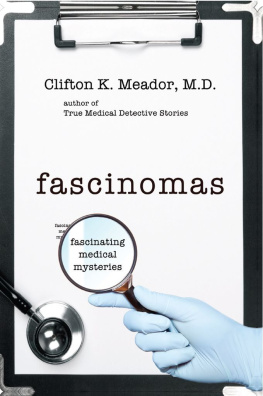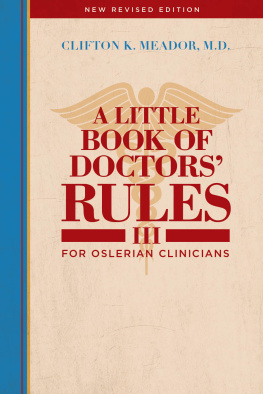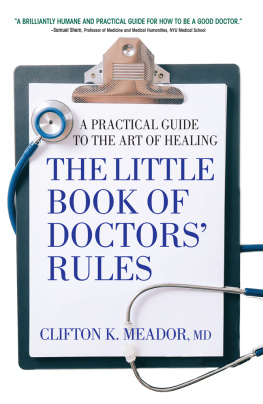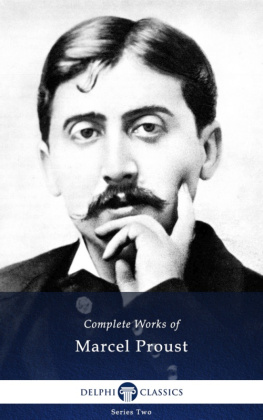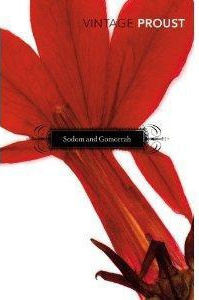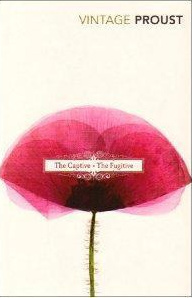Fascinomas -Fascinating Medical Mysteries.
Clifton K. Meador, M.D.
Fascinomas are fascinating by their very nature; they are stories that illustrate the reasoning of the master diagnostician faced with the complexities of daunting clinical challenges... They are object lessons in the essence of the shared journey between patient and physician: both are immersed in a particular clinical narrative, both hope for insights that can solve the illness experience, both try to fathom the idioms each contributes to the dialogue, and both are committed to this trusting alliance... Every patient is his or her own fascinoma.
Nortin M. Hadler MD MACP MACR FACOEM
Professor of Medicine and Microbiology/Immunology
University of North Carolina School of Medicine
Author of The Last Well Person, Worried Sick, Stabbed in the Back,
Rethinking Aging, and Citizen Patient
Clifton Meador is a superb story-teller who has been teaching and practicing medicine for more than 50 years. He knows how to plot a Medical Mystery. At the same time, he reveals how some of our best doctors arrive at the right diagnosis the old-fashioned way-by listening to their patients.
His experience has taught him that touching, asking questions, listening, and truly seeing the patient are the sensory arts that may be lost if physicians become too dependent on reading tests. His tales tell us what health care reformers mean when they talk about patient-centered medicine.
Maggie Mahar
Author of Money Driven Medicine
Editor of Healthbeatblog.
Using a simple and direct language, Dr. Meador delivers charm, wit, and always surprising stories that carry fundamental teachings dedicated to the best service to the patients and the profession. I have been reading his books with great delight since the 1990s, and have enjoyed translating them into Spanish for discussions with my students. The curious cases he presents in his books underscore how difficult it can be to reach the proper diagnosis and the right treatment without the dedication of true doctors.
Ximena Pez M.D.
Professor
Laboratory of Behavioral Physiology
School of Medicine
Universidad de los Andes
Mrida-Venezuela

Copyright 2013 Clifton K. Meador, M.D.
ISBN: 1491029277
ISBN 13: 9781491029275
Library of Congress Control Number: 2013913504
CreateSpace Independent Publishing Platform
North Charleston, South Carolina
Other Books
by Clifton K. Meador, M.D.
A Little Book of Doctors Rules, Hanley & Belfus, 1992
With R. H. Lanius, A Little Book of Nurses Rules, Hanley & Belfus, 1993
With W. Wadlington, Pearls from a Pediatric Practice, Hanley & Belfus, 1998
A Little Book of Doctors Rules II, A Compilation, Hanley & Belfus, 1999
With C. M. Slovis and K. D. Wrenn, A Little Book of Emergency Medicine Rules, Hanley & Belfus, 2000
With W. Wadlington and M. Howington, How to Raise Healthy and Happy Children, iUniverse, 2001
Med School, Hillsboro Press, Providence Publishing Corporation, 2003
Symptoms of Unknown Origin, A Medical Odyssey, Vanderbilt University Press, 2005
Twentieth Century Men in Medicine: Personal Reflections, iUniverse, 2007
Puzzling Symptoms: How to Solve the Puzzle of Your Symptoms, Cable Publishing, 2008
Med School, Revised Edition, Cable Publishing, 2009
True Medical Detective Stories, CreateSpace, 2012

Clifton K. Meador, M.D.
Author of True Medical Detective Stories
Table of Contents
The eye does not see what the mind is
not prepared to know
A Drug to Prevent a Complication Causes
the Complication
Sometimes the cause for a disease can
only be heard
Sometimes the Answer to a Single Question
Solves the Mystery
Foreword
Fascinoma combines the words fascinate with oma. The suffix oma usually denotes a growth or tumor. The Merriam-Webster Collegiate Dictionary defines fascinating as to be irresistibly attractive or to command the interest of or to be extremely interesting. Thus a fascinoma is medical slang for an unusually interesting medical case.
Fascinomas are patient stories that are indelibly stored in the minds of physicians. They are stories told over and over in hospital medical lounges. Every physician has at least one fascinoma to tell.
Following publication of True Medical Detective Stories this past year, I have been flooded with requests for more patient stories. True Medical Detective Stories was dedicated to the memory of Berton Roueche, noted writer for the New Yorker and the creator of the genre of medical detective stories. There were 19 patient stories in the book, most of which were solved by listening and talking.
Fascinomas, in most cases, are also medical detective stories. They often require some special effort by the patient or the physician or both to unravel the underlying causes. The causes of the illness may be obscure or rare or even unheard of before. Many fascinomas are so rare they are one time occurrences unique to the particular patient. Some, as you will read, are self inflicted.
Over the past year I have asked colleagues to share patient stories with me. This book is a compilation of 35 such medical mysteries or fascinomas. Nearly all emphasize the need for the physician to hear and understand the life narrative of the patient. They reinforce the old dictum that it is as important to know the patient with the disease as it is to know the disease.
My method in writing these patient stories has been to stick very closely to the clinical story and facts. By facts I mean all symptoms, physical findings, laboratory findings, and results of any imaging studies; these are all true. All of the patient identifiers have been changed. None of the patient names are true nor are any of the geographic details accurate. All have been altered to protect the privacy of the patient.
Some of the physicians allowed me to use their real names in the stories. All of the other physicians names are fictitious. At the end of each chapter, the physician who shared the clinical facts is identified.
Acknowledgements.
Many friends, colleagues, and physicians have contributed to this book.
I want to thank especially those physicians who have shared patient stories or who made editorial suggestions and comments about the manuscript. These physicians are Paul Barnett, Sidney R. Block, Jack Fisher, Robert Foote, Rand Fredericksen, Alan Graber, Jim Jirjis, Lloyd King, Robert Latham, John Newman, Ximena Paez, Alan Siegal, Betty Ruth Speir, William Stoney, Curt Tribble, Will Van Derveer, Larry Wolff, and Michael Zanoli.
I appreciate the suggestions or editorial comments of Virginia Fuqua-Meadows and my daughter Mary Kathleen Meador. I am thankful for the encouragement from Dr. Nortin Hadler and Maggie Mahar. My classmate Dr. Oscar Crofford and his wife Jane made many helpful suggestions.
I especially appreciate the superb editing job done by Beth Stein. She added so much to the telling of the stories.
And most of all I appreciate the support and editorial comments of my wife Ann Cowden Meador.
Cover Design:
Mark Cowden
Nashville
Chapter One
A Puzzling Paralysis
Being clumsy is one of the many unfortunate symptoms that often plagues young teenagers. But when Julia Wilkinson began bumping into furniture with some regularity, her mother Marie took note.
Next page
